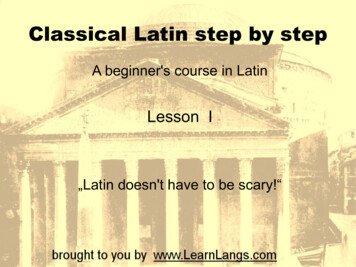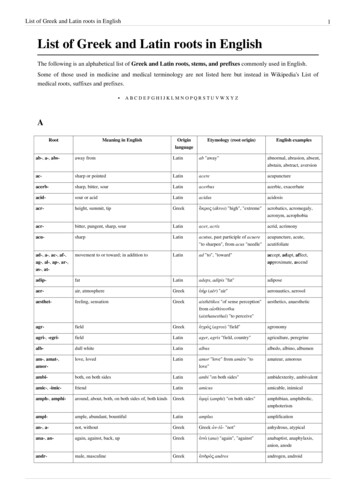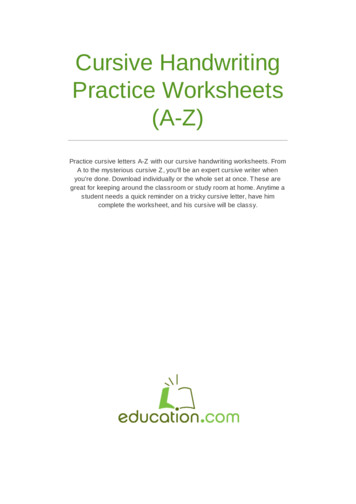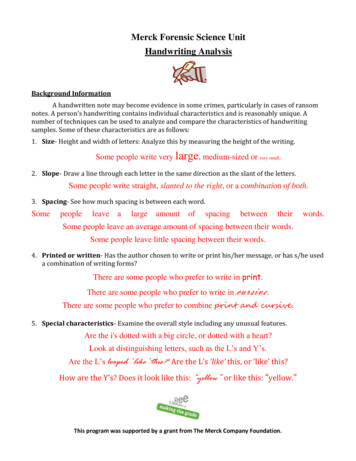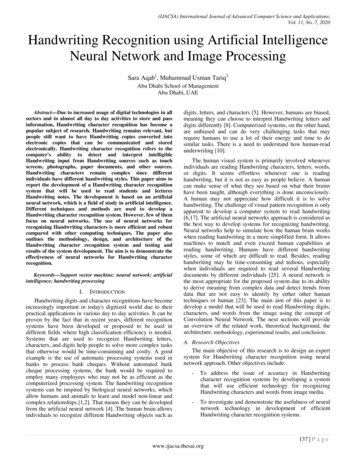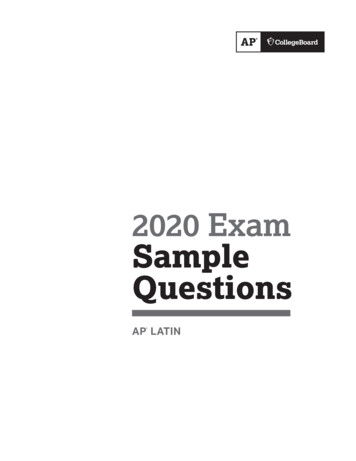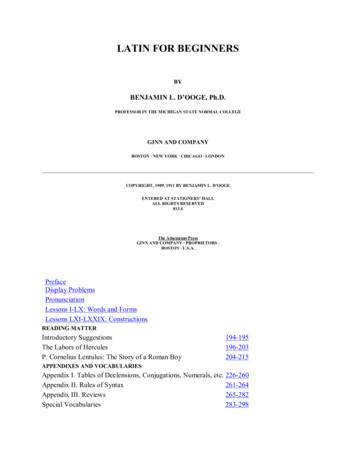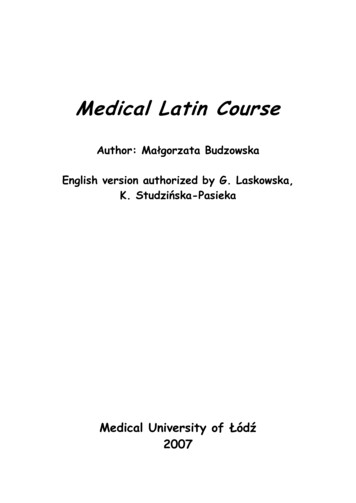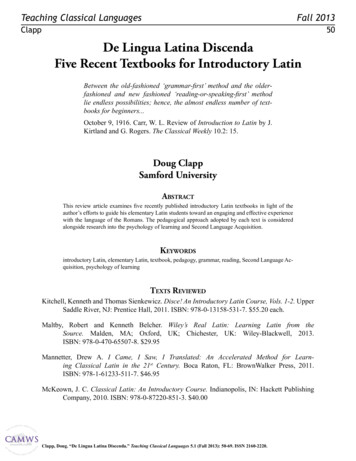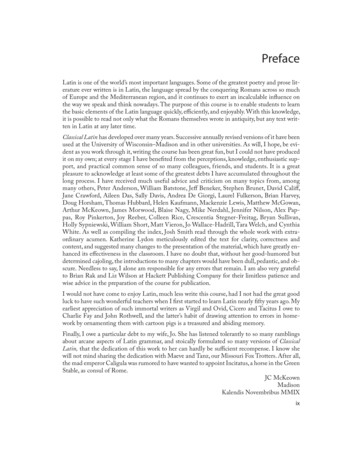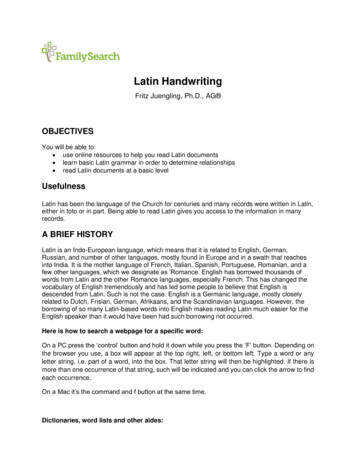
Transcription
Latin HandwritingFritz Juengling, Ph.D., AG OBJECTIVESYou will be able to: use online resources to help you read Latin documents learn basic Latin grammar in order to determine relationships read Latin documents at a basic levelUsefulnessLatin has been the language of the Church for centuries and many records were written in Latin,either in toto or in part. Being able to read Latin gives you access to the information in manyrecords.A BRIEF HISTORYLatin is an Indo-European language, which means that it is related to English, German,Russian, and number of other languages, mostly found in Europe and in a swath that reachesinto India. It is the mother language of French, Italian, Spanish, Portuguese, Romanian, and afew other languages, which we designate as ‘Romance. English has borrowed thousands ofwords from Latin and the other Romance languages, especially French. This has changed thevocabulary of English tremendously and has led some people to believe that English isdescended from Latin. Such is not the case. English is a Germanic language, mostly closelyrelated to Dutch, Frisian, German, Afrikaans, and the Scandinavian languages. However, theborrowing of so many Latin-based words into English makes reading Latin much easier for theEnglish speaker than it would have been had such borrowing not occurred.Here is how to search a webpage for a specific word:On a PC press the ‘control’ button and hold it down while you press the ‘F’ button. Depending onthe browser you use, a box will appear at the top right, left, or bottom left. Type a word or anyletter string, i.e. part of a word, into the box. That letter string will then be highlighted. If there ismore than one occurrence of that string, such will be indicated and you can click the arrow to findeach occurrence.On a Mac it’s the command and f button at the same time.Dictionaries, word lists and other aides:
1- FamilySearch Latin Genealogical Word Listhttps://www.familysearch.org/wiki/en/Latin Genealogical Word ListThis is the site to start with when looking for genealogical terms. It includes subsectionsfor topical vocabulary items, such as numbers, key words, and abbreviations. Thegeneral word list is Latin to English.2- Google Translate https://translate.google.com/This is an easy-to-use site. You can search either Latin to English or English to Latin.3- How to decline personal rence/how-to-decline-personal-names/This site shows you the many endings in all the cases of personal names. One caveat—in the first declension genitive and dative this site gives the simplified ending –e whereyou would normally see ae or æ.4- Latin Dictionary https://www.online-latin-dictionary.com/This is a wonderful dictionary with many terms. Of particular importance is that it gives thevarious declensions of the items, including given names. This will help you understand thegrammar.5- Lewis & Short: Latin-English dictionarySmith & Hall: English-Latin dictionaryDöderlein’s Hand-book of Latin SynonymesHorae Latinae: Studies in Synonyms and Syntaxhttps://www.latinitium.com/smithhall?sThis a very good set of dictionaries and other works that translate from English to Latin.Other aides:6- The Catholic Encyclopediahttp://www.newadvent.org/cathen/This encyclopedia will give detailed explanations of many terms dealing with the Catholicchurch. To increase your understanding of cultural items, see this encyclopedia.You will often encounter various abbreviations in your documents. The following two sites will givethe expansion of the abbreviations, which means that you will still have to translate the terms toa language that you understand.7- Wörterbuch lateinischer und deutscher Abkürzungen des späten Mittelalters und ks/records/item/58434-redirection2
8- Dizionario di Abbreviature Latine ed Italiani This book appears on two websites. Try themboth and see which you like more. The abbreviations and special symbols are arrangedalphabetically. However, some symbols are not really letters, but they will be grouped withthe letter that they most resemble. At the beginning of each letter of the alphabet there isa list of variant letters. Have a look at several letters to get an idea of how valuable thiswill be for projects/Cappelli/index.php?sphrase id 1213409- Latin Language and Script: Gallery of Latin Abbreviationshttp://sites.rootsweb.com/ chevaud/latin abbrev.htmThis site gives a number of abbreviations and explains them in detail.Part 1: Dictionaries, Word lists and other aides:Activity 1For this activity, find these words in the FamilySearch Latin Genealogical word list:https://www.familysearch.org/wiki/en/Latin Genealogical Word ListDo a control F (or command f) search for these words and write all the different Latin words thatyou find for each English word.Objectives of this activity:1- You will become familiar with the FS Latin word list2- You will learn how to search using the control F feature3- You will learn many Latin vocabulary itemsDeathmortuus, defunctus, obitus, denatus, decessus, peritus, mors,mortis, obiit, Witnesses3
GodmotherGodfatherFatherBuriedWifeActivity 2:Objectives of this activity:1- You will become familiar with the various word lists and dictionaries that you will need2- You will learn many Latin vocabulary itemsFor this activity, look at the document and see if you can recognize any of the cognates. Canyou more or less make out what is being said in this :1:3Q9M-CSK3-S3QB-W?cc 27902684300-000201%2F1Now, use these sites to look up each of the following words. You will not find all of the words inany one site, but will have to use both of them.4
FamilySearch Latin Genealogical Word Listhttps://www.familysearch.org/wiki/en/Latin Genealogical Word ListLatin Dictionary vespertinafilianostrohujatePart 2: Grammar: CasesLatin is what we call a synthetic, as opposed to an analytical, language. This means that Latinhas a tremendous number of word endings. How a noun or pronoun functions in a sentence isindicated by word endings, not by word order, as in English.CaseUseNominativeThis is the subject of the sentenceI baptized the child.GenitiveThis is the ‘owner’ of an item. In English, we oftenindicate this with ’s or of The child of Thomas and Mary (or Thomas’ andMary’s child) was baptized)DativeThis is the beneficiary of the action, i.e. the personfor whom something is doneFor John and Mary I baptized the child.AccusativeThis is the receiver of the actionI baptized the child.Here are the most common endings for three of the five noun groups, which we call‘declensions.’5
Case1st decl.2nd decl.3rd y 3:Objective of this activity:1- You will become familiar with the use of cases in order to determine who is doing what towhom in the sentence.From these two documents, look up the first two names in the box below and tell the case andfunction in the sentence of each one. A few extra names that are not in the documents havebeen added as well. Do the same for them. You can use the chart above (recommended) orthese two websites, but you should familiarize yourself with these sites:How to decline personal names /how-todecline-personal-names/ One caveat—in the first declension genitive and dative this sitegives the simplified ending –e where you would normally see ae or æ.Latin Dictionary ?cc 27902684300-000201%2F16
SK3-S3QB-W?cc 2790268NameCaseExample: BarbaraNominative. Subject of the sentence. The person being y 4 Translations and transcriptions:For the following documents, use the skills that you have developed and resources that youhave learned to translate and transcribe the following documents. The beginning document areeasy to transcribe. Lines will be provided for your work.When you transcribe or translate a document, you should stay true to the lines as they appear inthe documents. This means that if there are seven lines in the original document, you shouldhave seven lines in your transcription and, if possible, translation. If you are only extractinginformation, which you will often do, you do not need to stay true to the lines.For these exercises do not get hung-up on the surnames and place names. Those will bedependent on the area in which you are researching. Do pay special attention to given names,though.7
Document 1If you are working with a baptismal record and you see the words natus and renatus, what doyou automatically know about the person being baptized? What if you see nata and :3Q9M-CSK3-S3QB-Z?i 120&cc 27902688
Document CSK3-S3QY-1?i 121&cc 27902689
Document 310
SK3-S95M-3?i 274&cc 279026811
Document 4NB! Look up -que in the Latin word Q9M-CSTT-X968-9?i 249&cat 9681112
Document CSTT-X968-9?i 249&cat 9681113
Document CSTT-X9DW-J?i 169&cat 96811Document 714
STT-X96J-2?i 221&cat 96811Document 8Before you translate the document, look at the numbers and letters in the right-hand column.What do they mean; what is the date? Answer: Those are the date: 9th of September15
STY-73TD-T?i 27016
Document CSK3-W9YQ-4?cc 27902684300-000201%2F117
Document -CSTY-73YH-918
Document 11Objective of this activity:1- You will become familiar with various works dedicated to Latin abbreviations.To start this activity, read or skim this page well enough that you at least know generally what isthere and can refer to it later when you need help. No one can remember all these things, butfamiliarity and knowing how to find information is valuable:http://sites.rootsweb.com/ chevaud/latin abbrev.htmBefore you start with Document 11, refer to document 4 and look at the abbreviation that is thesecond-to-last word in the last full line. What is it? Look that up in the one of thefollowing works. For document 11, you are given a document that includes a number ofabbreviations. Use these tools to expand the abbreviations that are underlined in the /projects/Cappelli/index.php?sphrase id 121340Choose whichever version of this book you like better. Remember to look at the beginning ofseveral letter sections to see variant letter forms. You will need that in order to figure out someof the letters. Also know that not every abbreviation can be listed in any work. There are simplytoo many. But if you can find something that is close or partial, you may have found themeaning that you are looking for.If you need help reading the text, look at the URL. But still look up the abbreviations in the book.19
http://sites.rootsweb.com/ chevaud/latin Fg6 8v.htm 2020 by Intellectual Reserve, Inc. All rights reserved. No part of this document may be reprinted or reproduced inany form for any purpose without prior written permission.20
learn basic Latin grammar in order to determine relationships read Latin documents at a basic level Usefulness Latin has been the language of the Church for centuries and many records were written in Latin, either in toto or in part. Being able to read Latin gives you a

